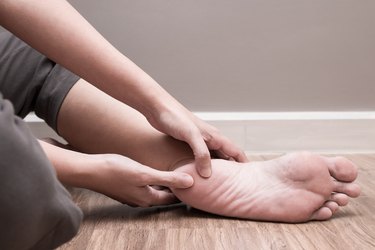
While it's true that hard workouts involve some temporary discomfort, no workout should cause pain in your bones. As noted at Johns Hopkins Medicine, bone pain after a workout or even while you are working out, is a classic example of "bad" pain — a signal that something has gone wrong.
Bone Pain After a Workout
Video of the Day
Your bones are living tissue, just like your muscles, tendons and ligaments. And just like your muscles, your bones respond to stress by rebuilding themselves to be stronger. But that bone-strengthening process — called remodeling — takes some time.
Video of the Day
As explained by Johns Hopkins Medicine, if you stress your bones too much, too quickly, they will actually begin to fail. Pain along the bone during activity is the first sign of that failure; with continuing stress, that point of failure can turn into a stress fracture or even a complete break.
That's why experts so frequently stress the need to work into exercise gradually, giving your muscles, tendons and ligaments — and yes, your bones too — time to adapt.
Needless to say, if your bones hurt when lifting weights, you should stop right away. Johns Hopkins lists some indications that the bone pain — or other "bad exercise pain" — you're feeling signals a serious concern:
- If the pain doesn't go away with rest
- If the pain lasts long after exercise
- If the pain is constant or increases over time
- If the pain affects your sports performance
- If the pain wakes you from sleep or affects your function outside of sports
- If the pain requires increasing the amount of pain medication
Even if you're not lifting weights, there are other ways to stress — or overstress — your bones during exercise. For example, you might notice that your bones ache after running.
Sometimes the solution is relatively simple — for example, you might need to run on a softer surface or the midsole cushioning in your shoes might be worn out. But that ache could also be a sign that your body isn't ready for that level of repeated high-impact exercise, or that you're developing an injury.
Certain other conditions can cause bone pain. Even if they're not directly connected to exercise, you might become aware of the symptoms when you work out. The U.S. National Library of Medicine (NLM) lists a number of potential causes for bone pain or tenderness, including:
- Injury
- Infection
- Cancer
- Disruption of blood supply
- Overuse
- Osteoporosis
The NLM advises that if you have bone pain and don't know what the cause is, you should see your healthcare provider.
Read more: Causes of Sudden Joint Pain
Exercise Might Help
It's true that exercise can cause bone pain if you have pre-existing conditions or if you lay on too much stress too quickly. But when used appropriately, exercise might also reduce your risk of injury and soothe bone pain symptoms caused by certain issues.
As the Mayo Clinic notes, "When arthritis threatens to immobilize you, exercise keeps you moving." Just a few of the benefits they cite for exercising with arthritis include maintaining bone strength, strengthening the muscles around your joints, improving your balance, helping you control your weight and enhancing your overall quality of life.
If you have arthritis, your team of medical professionals can help you decide which types of exercise are right for you. They might recommend aerobic exercise, strength-training workouts or stretching exercises to improve or maintain your range of motion.
The Arthritis Foundation also recommends certain types of aerobic and strength-training exercise for those with rheumatoid arthritis, noting that both types of workout have been shown to help ease pain from this condition.
And finally, as the National Osteoporosis Foundation points out, both resistance-training workouts and weight-bearing aerobic exercises can help you strengthen your bones. However, they also warn that not all exercises are safe when you have osteoporosis. For example, forward bends may increase your risk of breaking a bone in your spine. Because of that, they recommend consulting a physical therapist to determine which exercises are safe and appropriate for you.
Read more: What Is Healthy Bone Mass?
- Johns Hopkins Medicine: "'Good Pain' Versus 'Bad Pain' for Athletes"
- Mayo Clinic: "Exercise Helps Ease Arthritis Pain and Stiffness"
- National Osteoporosis Foundation: "Weight Bearing"
- U.S. National Library of Medicine: "Bone Pain or Tenderness"
- Arthritis Foundation: "Best Exercises for Rheumatoid Arthritis"
Is this an emergency? If you are experiencing serious medical symptoms, please see the National Library of Medicine’s list of signs you need emergency medical attention or call 911.